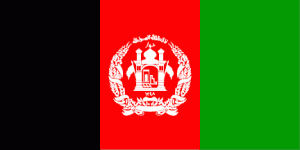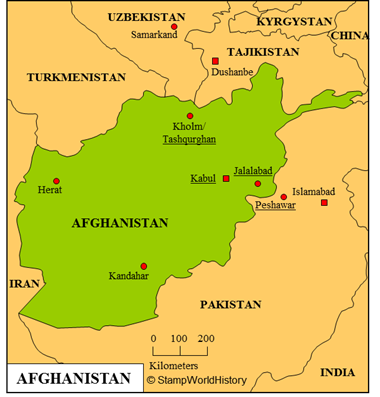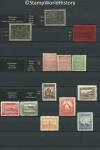افغانستان

Afghanistan
Quick reference
General issues: Emirate in British sphere of influence 1871-1919, Emirate 1919-1926, Kingdom 1926-1973, Republic 1973-1978, Democratic republic 1978-1992, Provisional government 2001-2004, Islamic republic 2004-Present
Country name on general issues: Afghan Post, Postes Afghanes, Afghanistan
Special issues: District issues Jalalabad, Kabul, Peshawar, Tashqurghan 1876-1878
Currency: 1 Rupa = 3 Abasi = 6 Senar = 12 Shahi 1871-1921, 1 Rupa = 60 Peisa; 1 Kran = 6 Shahi = 30 Paisa 1921-1927, 1 Afghani = 100 Pul 1927-Present
Population: 4 550 000 in 1901, 30 550 000 in 2013
Political history Afghanistan
Afghanistan is a country in southern Asia. Afghanistan as a unified state is formed in the 18th century. In the 19th century Afghanistan is part of ‘The great game’, the struggle for power in Asia between Great Britain and Russia. In the second part of the 19th century this struggle in Afghanistan is won by Great Britain: Afghanistan becomes a de facto British protectorate. In 1919, Afghanistan frees itself from British influence to become a fully independent emirate. In 1926, the emir is crowned king of the kingdom of Afghanistan. The borders of Afghanistan have long been disputed. In the last part of the 19th and the early part of the 20th century the borders are defined through treaties with the neighboring countries.
The history of the country may be characterized as that of a constant struggle between traditional Islam and modernization. Modernization through an orientation on the Western world as during the 1920’s or modernization through the introduction of the communist/Marxist ideology in the 1970’s and 1980’s. Conflicts between these groups in the Afghan society have several times led to civil war.
Afghanistan is a kingdom until 1973, when the republic of Afghanistan is proclaimed. In 1978, the communists gain power in Afghanistan and the democratic republic of Afghanistan is proclaimed. The instability of the country makes the Soviet Union invade the country in the same year – an occupation that will last until 1989. When the Soviet Union has left the country, the communist regime stays in power, with Soviet support, until 1992. In 1992, the moderate Islamic opposition comes to power and proclaims the Islamic republic of Afghanistan. In 1996, the radical Islamic Taliban come to power and proclaim the Islamic emirate of Afghanistan. None of the governments, since 1978, have managed to control all of Afghanistan, the country being in a constant state of civil war.
The attacks of September 11th, 2001, on the World Trade Center in New York are attributed to al-Queda, a radical organization that at the time was based in Afghanistan. Reason for an international coalition led by the United States to invade Afghanistan. The invasion topples the Taliban regime in Afghanistan. After a period with a provisional government, Afghanistan in 2004 turns into an Islamic republic with a democratic constitution.
Postal history Afghanistan
The first stamps are issued in Afghanistan in 1871. Special issues appear between 1876 and 1878 for each postal district. These stamps are issued in different colors for the postal districts of Jalalabad, Kabul, Peshawar – the Afghan office in Peshawar in neighboring Pakistan – and Tashqurghan.[1]The catalogs differ in the way they list these issues, source used is the Michel catalog.
The period of civil war between 1989 and 2001 presents a complex picture. Scott and Stanley Gibbons note that the Afghan postal authorities have labelled all issues since 1989 as unauthorized. Thus, Scott and Stanley Gibbons list no issues for this period. Michel, however, has listings for issues that appeared between 1996 and 2001. Michel states that these issues were authorized by the government that was, at the time, internationally recognized as the legitimate government of Afghanistan. Thus, even though this government controlled only limited areas of the country as most of the country was controlled by the Taliban, Michel has a listing. Michel does note that for the issues since 1998 postal use is doubtful.
The stamp shown is of the Buddha statue in Bamiyan, one of the major cultural sites of Afghanistan. The stamp was issued in 1932, a similar stamp was issued in 1951. Both stamps had to be withdrawn shortly after being issued due to protests of the Islamic population. The Buddha statue in Bamiyan was destroyed by the Taliban in 2001.
Album pages
← Previous page: AdenNext page: Ajman →






